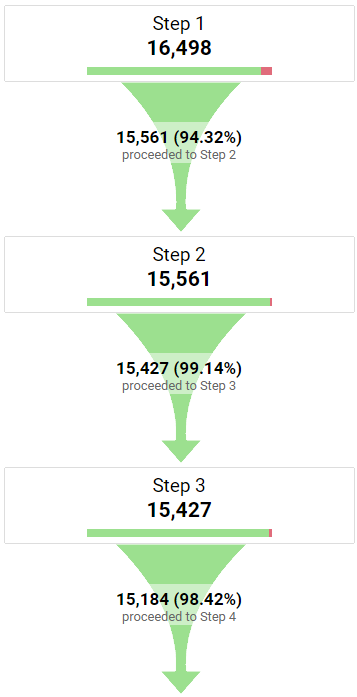Discover the Limitations of Google Analytics Goals: Revealing the Information Types That Remain Untrackable
As companies significantly rely upon data-driven decision-making, recognizing the restrictions of devices like Google Analytics becomes paramount. While Google Analytics Goals deal useful insights right into user communications, there exist information types that avoid monitoring, posturing challenges to a comprehensive understanding of individual actions. These untrackable data kinds raise concerns concerning the accuracy and efficiency of the analytics information that organizations greatly trust for their electronic approaches. Curious to reveal the hidden blind areas in your information analysis process?
Incomplete Customer Trip Tracking
Incomplete customer trip tracking within Google Analytics can hinder the ability to properly analyze user habits. When the user journey is not completely tracked, there are voids in the data that prevent a thorough understanding of just how users interact with a web site. This lack of insight can cause missed chances for optimization and improvements to the customer experience.
One usual issue with insufficient individual journey tracking is the lack of ability to see the complete course that individuals take in the past finishing a goal or leaving the website. Without this info, it is testing to determine where individuals may be encountering obstacles or friction factors that stop them from converting. Additionally, insufficient monitoring can cover the impact of particular marketing initiatives or web site changes on customer actions.
To address this constraint, it is critical to establish up appropriate monitoring systems within Google Analytics to catch the entire customer journey. This may entail establishing occasion tracking, objective funnels, or utilizing devices like Google Tag Manager to ensure that no important communications go unrecorded. By getting a comprehensive sight of the individual trip, internet site owners can make more informed choices to boost customer engagement and drive conversions.
Attribution Obstacles
Navigating via acknowledgment difficulties in Google Analytics needs a complete understanding of just how various touchpoints add to the general conversion process. Acknowledgment obstacles occur from the intricacy of modern client journeys, where users connect with numerous networks prior to converting. Google Analytics provides different attribution models like very first touch, last touch, and direct, each offering a different point of view on exactly how debt is designated to touchpoints along the conversion course. Nonetheless, these models may not constantly properly show the real influence of each touchpoint on the conversion.
One typical attribution obstacle is the trouble in associating conversions to the correct resource, specifically in instances where users interact with several channels prior to transforming. Additionally, cross-device monitoring presents another acknowledgment challenge, as individuals usually switch over in between tools during their trip, making it testing to track their interactions flawlessly.
Offline Conversions
Provided the challenges linked with associating conversions properly in online networks, the measurement of offline conversions offers a significant chance for marketers looking for an extra extensive understanding of their consumers' journey. Offline conversions describe activities that customers absorb the real world, such as making acquisitions in brick-and-mortar shops or over the phone, attending occasions, or involving with published materials - what data is google analytics goals unable to track. These conversions are essential for companies that run both online and offline, as they provide valuable insights into the efficiency of advertising projects across numerous touchpoints
Tracking offline conversions generally postured a significant difficulty for marketing professionals, as it was testing to connect these actions back to specific on the internet communications precisely. Nevertheless, with More Bonuses advancements in technology, such as the integration of CRM systems, distinct identifiers, and voucher codes, organizations can now bridge the void in between online and offline information to obtain an extra all natural view of customer behavior. By effectively determining offline conversions, marketers can enhance their methods, allocate resources a lot more effectively, and ultimately improve the general customer experience.
Cross-Device Tracking
Cross-device tracking plays an important role in understanding the interconnected nature of customers' digital communications throughout several tools. In today's omnichannel world, where users seamlessly switch over between tablets, smart devices, and desktops, tracking their habits throughout these devices is essential for marketers to acquire an extensive sight of their customer journey.

In addition, privacy issues and guidelines such as GDPR and CCPA have better complex cross-device tracking. With users demanding even more control over their data and boosted limitations on monitoring modern technologies, marketers should find privacy-compliant and cutting-edge ways to link individual communications throughout devices.
Dynamic Content Engagement
Understanding individual involvement with vibrant web content is essential in maximizing electronic marketing strategies for boosted audience interaction. Dynamic web content describes web site aspects that alter based on customer actions, choices, or other elements, offering a personalized experience. However, tracking user communications with vibrant material postures challenges for conventional analytics tools like Google Analytics.
While Google Analytics can track fundamental communications like clicks and web page views, it might have a hard time to capture even more nuanced interactions within dynamic web content. what data is google pop over to this web-site analytics goals unable to track. Metrics such as time invested on certain vibrant aspects, hover activities, or interactions within pop-ups are usually not conveniently measurable making use of common monitoring approaches. This restriction prevents marketers' ability to totally understand just how individuals are engaging with vibrant content and customize their techniques accordingly

Verdict
To conclude, Google Analytics goals have restrictions in tracking incomplete individual trips, connecting conversions properly, capturing offline conversions, tracking cross-device interactions, and determining vibrant web content involvement. These constraints highlight the value of checking out extra monitoring approaches and tools to gain a more extensive understanding of customer actions and conversions past what Google Analytics can supply.
While Google Analytics Goals offer beneficial understandings right into individual communications, there exist information types that avoid tracking, posing challenges to a detailed understanding of individual habits.Incomplete individual journey tracking within Google Analytics can hinder the ability to precisely evaluate user actions. When the user journey is not totally tracked, there are spaces in the data that avoid an extensive understanding of how users connect with a website.One common concern with insufficient user trip monitoring is the lack of ability to see the complete course that individuals take before finishing an objective or leaving the site. By getting a detailed view of the customer journey, website proprietors can make more enlightened choices to improve user involvement and drive conversions.